Lipik presented in the cultural magazine Croatian Review
http://www.croatia.org/crown/articles/9946/1/-Lipik-presented-in-the-cultural-magazine-Croatian-Review.html
By Prof.Dr. Darko Zubrinic
Published on 03/22/2010
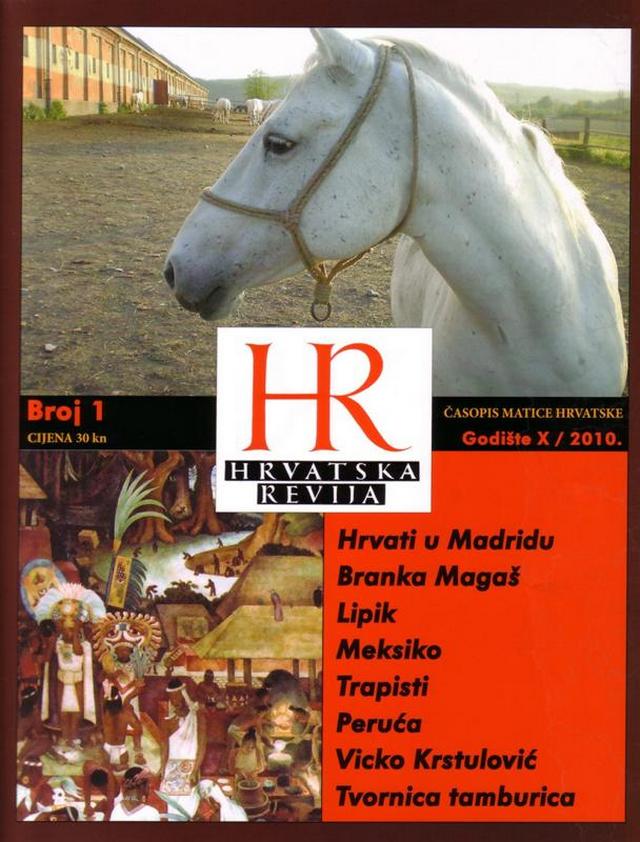
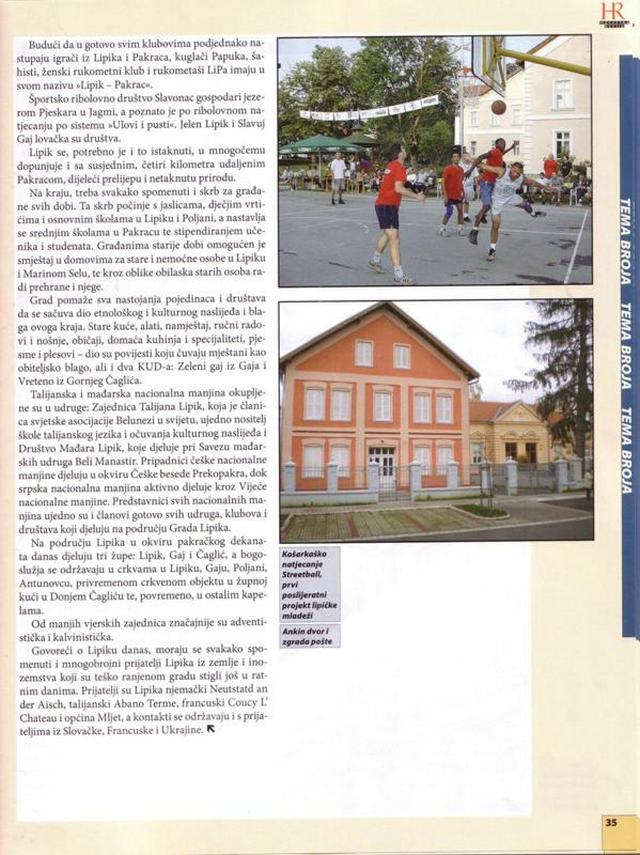
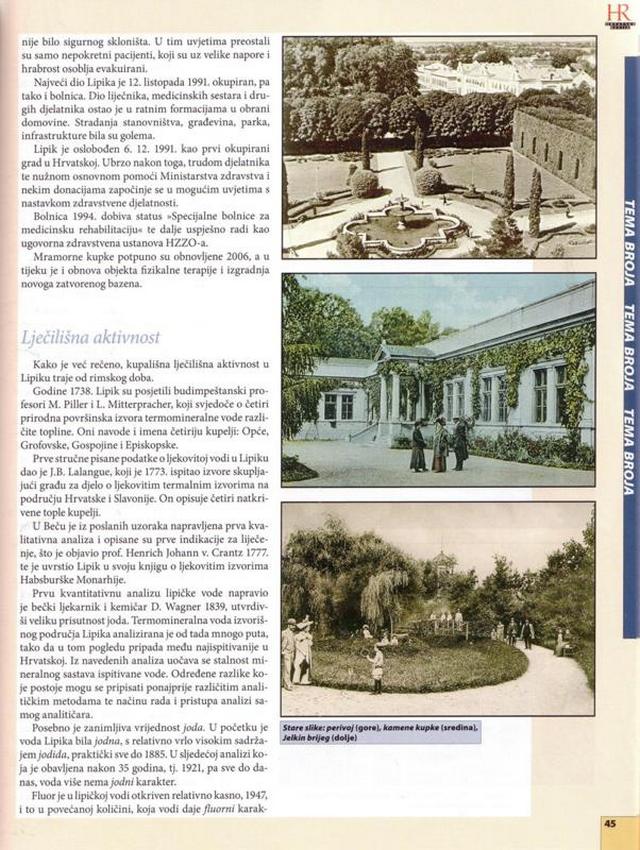
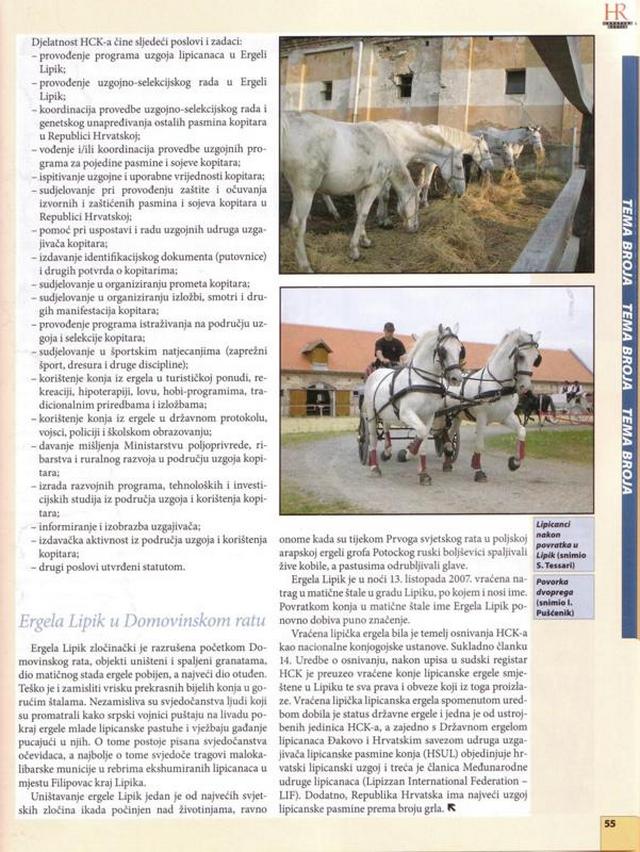
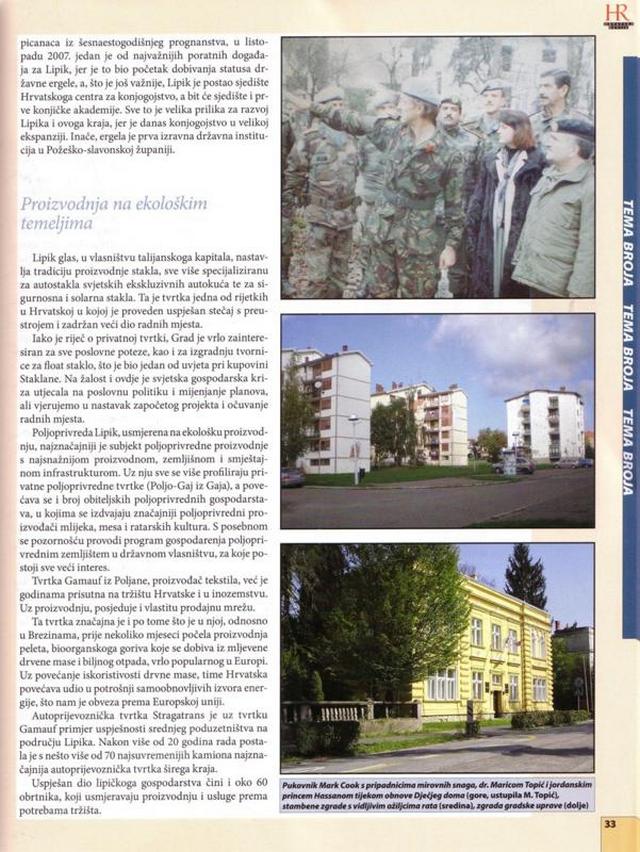
 | The city of Lipik was presented in Croatian Review, a cultural and political magazine that was first published in 1928. From 1945 to 1950 the magazine was prohibited. Thanks to the Croatian emigrants Vinko Nikolić and Antun Bonifačić, the magazine came back to life in Argentina. In the years between 1951 and 1990 it was published in Buenos Aires and Paris and then in Munich and Barcelona. Since 1991 it has been published in Zagreb by Matica Hrvatska. |
The first Croatian city that the magazine presented as the "topic of the issue"

Hrvatska revija [Croaitan Review] with Lipik as the topic of the 2010 No1 issue.
| "Hrvatska revija" predstavila Lipik Grad Lipik je dobio veliku čast biti predstavljen u časopisu Hrvatska revija (broj 1/godina 2010.) koju izdaje Matica Hrvatska i to kao prvi hrvatski grad obrađen u Reviji kao „tema broja". Hrvatska revija je hrvatski kulturno - politički časopis čiji je prvi broj izašao davne 1928. godine. Od 1945. do 1950. časopis je bio zabranjen, da bi zatim opet počeo s djelovanjem u Argentini zahvaljujući hrvatskim emigrantima Vinku Nikoliću i Antunu Bonifačiću. U razdoblju od 1951. do 1990. godine izlazio je u inozemstvu kao časopis hrvatske političke emigracije, u Buenos Airesu i Parizu, a zatim u Münchenu i Barceloni. Od 1991. godine ponovno izlazi u Hrvatskoj u Zagrebu u nakladi Matice hrvatske. Ovdje prenosim uvodnik glavnog urednika Hrvatske revije Mladena Klemenčića koji će najbolje opisati odabir Lipika za temu broja ovog cjenjenog časopisa: "U devet godina ovog tečaja Hrvatske revije objavili smo mnogo pojedinačnih priloga o hrvatskim gradovima pa i gradićima, no nijednom nismo za temu broja odabrali cjelovitiju obradu nekog hrvatskog grada. Nije riječ o tome da naši gradovi ne bi zavrijedili svestranu pozornost, naprotiv mnogi od njih bili bi zahvalne teme za takvu obradu. Prednost smo dali drugačijem, tematskom pristupu pa smo u više navrata obrađivali pojedine teme u odabranim hrvatskim gradovima. Podsjećamo naše čitatelje na tematske blokove o svecima zaštitnicima, o kavanama, kinematografima ili pak zavičajnim muzejima u hrvatskim gradovima. Odabir Lipika za središnju temu ovoga broja stanovita je iznimka u odnosu na takvu praksu. Ovoga puta u središtu pozornosti Hrvatske revije zaista se našao jedan hrvatski grad i to ne iz skupine onih većih i mnogoljudnijih. Na odluku da cjelovitije predstavimo Lipik utjecala je ponajprije činjenica da je riječ o jedinstvenom gradu u Hrvatskoj kao i o gradu koji se u današnje vrijeme često nalazi podalje od pozornosti društva. U usporedbi s ostalim hrvatskim gradovima Lipik ima nekoliko posebnosti. Do Drugog svjetskog rata Lipik je bio perjanica kontinentalnog turizma ne samo u Hrvatskoj nego u cijeloj tadašnjoj Jugoslaviji. Kao lječilišno i topličko mjesto bio je poznat i izvan granica države. Bečki putopisci opisivali su ga kao „mjesto koje liječi i dušu i tijelo". Osim po ljekovitoj vodi Lipik je bio poznat i po ergeli konja, što je dodatno povećavalo svojevrsnu turističku ekskluzivnost toga mjesta. Nakon Drugog svjetskog rata nastupilo je nazadovanje Lipika, a najteže dane doživio je u jesen 1991. kada je grad pretrpio teška razaranje, jedno vrijeme bio i okupiran, ergela doslovce ukradena, a stanovništvo izloženo pogibiji. Uz podatke koji govore o boljoj prošlosti, u prilozima naših autora nalaze se detaljne informacije upravo o tom razdoblju. U kratkom vremenu bezumlja uništene su vrijednosti koje su stvarane kroz više naraštaja. U člancima doznajemo ponajprije o sadržajima koji Lipik čine posebnim, no ponešto i o onome što je izgubljeno u ratnome vihoru kao i o građevinskoj i gospodarskoj obnovi grada, naporima lipičkoga stanovništva, napose mladeži, da se oživi zabava i rekreacija, kao i o ljudima koji su pomogli ili pomažu da se pročuje glas o Lipiku, kao što su britanski pukovnik Mark Cook, pripadnik mirovnih snaga u Hrvatskoj koji je pomogao obnovu Dječjeg doma, ili naš znameniti glazbenik Nenad Bach, koji promidžbeno podupire Lipik. Jedan od takvih, tihih a dragocjenih prijatelja Lipika, je i zagrebački profesor Darko Žubrinić, koji nam je dao inicijalni poticaj za ovu temu ... " (Mladen Klemenčić, 2010.) Autori članaka o Lipiku su: Antun Haramija (gradonačelnik Lipika), Jasminka Stričević (direktorica Zdravstveno rekreacijskog centra Lipik), Otto Kraml (spec. fizijatar i zamjenik ravnatelja Bolnice za spec. med. Rehabilitaciju Lipik), Stjepan Horvat, Mato Čačić (ravnatelj Hrvatskog centra za konjogojstvo), Stanko Špoljarić (viši kustos Umjetničkog paviljona u Zagrebu) i Vijoleta Herman Kaurić (Hrvatski institut za povijest). Treba naglasiti da je "ipičko izdanje" Hrvatske revije najdetaljnije predstavljanje Lipika u tiskanim medijima još od Domovinskog rata, a rezultat je to zapravo djelovanja zagrebačkog sveučilišnog profesora Darka Žubrinića koji je i dosada činio mnogo da se glas o Lipiku čuje i izvan Lijepe naše. Zajedno s njim svoju borbu za Lipik vode i mladi ljudi Lipika koji su 1999. godine utemeljili noćni košarkaški turnir STREETBALLipik koji je postao najveći i najposjećeniji društveni događaj u gradu. I na kraju ne mogu a da ne povučem dijagonalu sa Nenadom Bachom koji je nakon posjeta Lipiku u lipnju 2008. svoje razmišljanje ponudio cijelom svijetu, a posebno hrvatskoj dijaspori: "Slavonija ima dušu i kulturu poduzetništva. Pogledajte što će Slavonija postati u narednih 7 do 10 godina. Hrvati diljem svijeta obratite pozornost i ulažite u Slavoniju. Ovo će biti nova Istra. Ne čekajte Zagreb da vam pošalje pomoć. Pomognite sami sebi, imate sve što je potrebno da postanete najbogatiji dio Hrvatske". Ivan Pušćenik, Lipik, Hrvatska | Lipik presented in the Croation cultural magazine "Croatian Review" The city of Lipik had the honor to be presented in the magazine "Hrvatska revija" (number 1/ year 2010) that is published by Matica Hrvatska. It is the first Croatian city that the magazine presented as the "topic of the issue". "Hrvatska revija" is a Croatian cultural and political magazine that was first published in 1928. From 1945 to 1950 the magazine was prohibited. Thanks to the Croatian emigrants Vinko Nikolić and Antun Bonifačić, the magazine came back to life in Argentina. In the years between 1951 and 1990 it was published abroad as a magazine of Croatian political emigration, first in Buenos Aires and Paris and then in Munich and Barcelona. Since 1991 it has been published in Zagreb by Matica Hrvatska. I would like to quote the introduction written by Mladen Klemenčić, the chief editor of the magazine "Hrvatska revija", because his words describe in the best way, why Lipik was chosen to be the "topic of the issue" of this respected magazine: "In the nine years of this topic in 'Hrvatska revija', we have published many individual inserts about Croatian cities, even little cities, but we have never decided to entirely present a Croatian city as the topic of the issue. It is not about the fact that our cities don't deserve all-around attention, quite the opposite is the case, many of them would be an appreciated topic for such an edition. However, we had another prior thematic approach and so it took us several attempts to edit individual topics of chosen Croatian cities. We would like to remind our readers of the thematic sections about patron saints, cafes, cinematography and even local museums in Croatian cities. The choice of Lipik as a central theme of this issue is a certain exception regarding the previous topics. This time a Croatian city, not one of the bigger ones or with many residents, is in the center of attention of 'Hrvatska revija'. The fact that Lipik is a unique city in Croatia and a city in today's time that finds itself aloof from society’s attention, affected the decision to fully present this city. In comparison to the other Croatian cities, Lipik has a couple of unique features. Up until the Second World War, Lipik was the plume of the continental tourism, not only in Croatia, but in whole, at that time, Yugoslavia. It was also famous for its thermal bath and as a health resort, even outside the national boarder. Viennese travel reporters described it as "a place that heals body and soul". Lipik was not only famous for its healthful water, but also for its horse farm, that added to the touristic exclusiveness of this city. After the Second World War Lipik experienced a retrogression. The hardest days were those in autumn of 1991 when the city had to endure vast devastation. For some time it was even occupied, the horse farm literally stolen and the inhabitants exposed to danger. Along with the information that talks about a better past, located in the enclosures of our authors, there is more detailed information about that period. Within that short time of irrationality, precious things that were created by many generations, were destroyed. In the articles we first learn about features that make Lipik so special, but also something about what was lost during the attacks of the war, as well as about the structural and economical renewal of the city and the efforts of Lipiks' citizens, especially the younger ones, to revive entertainment and recreation. We also learn about people who have helped or still help Lipik to gain a voice, like the British Colonel Mark Cook, who is a member of the UN peacekeeping troops in Croatia and who helped to rebuild the orphanage in Lipik or Nenad Bach, a famous musician, who supports Lipik through advertisement. One of these quiet but precious friends of Lipik is also Darko Žubrinić, a university professor from Zagreb, who gave us the initial encouragement for this topic …" (Mladen Klemenčić, 2010) The authors of this article about Lipik are: Antun Haramija (the mayor of Lipik), Jasminka Stričević (headmistress of the health and recreation centre in Lipik), Otto Kraml (specialized physiatrics and deputy director of the hospital for special medical rehabilitation in Lipik), Stjepan Horvat, Mato Čačić (director of the Croatian center for horse breeding), Stanko Špoljarić (senior curator of the Art pavilion in Zagreb) and Vijoleta Herman Kaurić (Croatian Institute of History). One thing that has to be emphasized is that the "Lipik issue" in "Hrvatska revija" presents Lipik in the most detailed way that a printed media has ever done since the Croatian War of Independence. It is the result of the performances of Darko Žubrinić who has done so much in recent years, so that the voice of Lipik could also be heard outside of our beautiful country. Together with him, the young people of Lipik fight a battle for Lipik and in 1999 they founded STREETBALLipik, a basketball tournament that takes place at night. It became the biggest and most visited social event in the city. In the end I cannot resist but to draw attention to Nenad Bach, who, after his visit in Lipik in June 2008, presented his thoughts to the whole world, and especially to the Croatian diaspora: "Slavonia has a soul and culture of entrepreneurship. See what Slavonia does in the next 7-10 years. Croatians around the world, pay attention and invest in Slavonia. This will be next Istria. Do not wait for Zagreb to send you help. Help yourself, you have everything you need to become the richest part of Croatia". Ivan Pušćenik, Lipik, Croatia |
Translated from Croatian by Nada Milemdi, Graz, Austria




Formated for CROWN by prof.dr. Darko Žubrinić
Distributed by www.Croatia.org . This message is intended for Croatian Associations/Institutions and their Friends in Croatia and in the World. The opinions/articles expressed on this list do not reflect personal opinions of the moderator. If the reader of this message is not the intended recipient, please delete or destroy all copies of this communication and please, let us know!